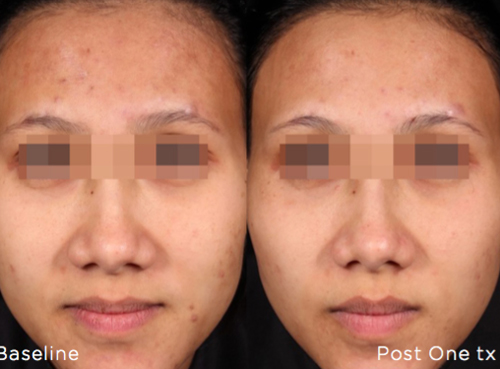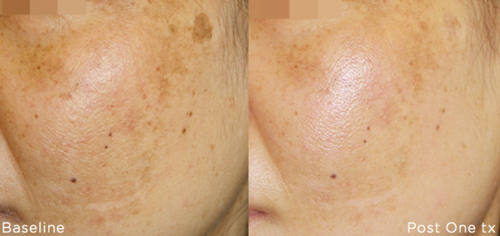Of all pigmentation cases you see in your salon, spa or clinic, the so-called “mask of pregnancy”, melasma, is likely the most distressing for your patients.
It is deep, dark and capricious. You may achieve stunning results and then … it’s baaack. It can develop during pregnancy because of hormonal swings in the body, but also from hormonal fluctuations at any stage of life (eg. menopause) and is significantly worsened by UV exposure. It can affect men, too.
After pregnancy it often fails to resolve post-delivery and can become a debilitating cosmetic concern that is difficult to be disguised by even heavy duty camouflage makeup.
Most patients will have large blotches on the cheeks or forehead, but occasionally thinner patches of pigmentation will show over the eyebrows or upper lip.
Picosecond laser technology has been a major game changer in the tattoo removal industry over the past couple of years.
But an “incidental” by-product – that of treating pigmentation – looks as if it will far outstrip the results and revenue potential of using picosecond lasers for removing tattoos: currently, the global market for treating pigmentation is twice that of tattoo removal.
Pico Genesis is a gentle skin revitalisation therapy effective for all skin types, made possible by Cutera’s enlighten – the first multi-wavelength (1064 nm and 532 nm) and picosecond-plus-nanosecond multi-application laser platform.
It is performed only in doctor-operated clinics but your clients who struggle with melasma and other stubborn pigmentation that won’t respond satisfactorily to other treatments will thank you wholeheartedly for the referral with their continued trust and loyalty – and their own referrals to you.
Enlighten revolutionised treatment of unwanted tattoos when it was launched on the Australian market two years ago, but has now found an even bigger application in the treatment of benign pigmented lesions, such as the notoriously stubborn melasma.

While traditional nanosecond lasers have been considered the standard of care for the removal of benign epidermal and dermal pigmented lesions, Enlighten brings important advances in the treatment protocol – for, as an example, unwanted freckles, sun spots, age spots, and generally making skin appear lighter, brighter and more even – as well as for global facial “laser toning” rejuvenation.
Pico laser technology is measured in pico seconds (one trillionth second) while Q-Switch (traditional) lasers are measured in nano seconds (one millionth of a second).
The speed of the pico technology shatters the pigment or ink into smaller (indeed, tiny) particles than Q-switch, which enables the body to clear the colour faster.
Its ultra-short pulse duration goes beyond photo-thermal (heat) action creating an intense photo-mechanical impact resulting in greater disruption of the target for better clearance with fewer treatments, and without injury to the surrounding skin.
“Melasma, particularly, can be a real demon to treat, and most of the time we manage rather than cure it,” says Canadian plastic surgeon Dr Rick Green, who visited Australia recently for the Non- Surgical Symposium and to hold training workshops on behalf of Cutera around the country.

“We instruct patients to diligently use sunscreen every day, even in winter.
“At our practice [in Salmon Creek, Vancouver] we have experienced varying degrees of success in using laser to treat melasma over the years.
“Laser applications that treat superficial pigmentation due to sun damage tend not to work as well when the pigment is deeper, as in melasma.
“In the past six months, though, we have been using enlighten to go after this very stubborn pigmentation, with very encouraging results. A bonus is we can use it on all six Fitzpatrick skin types.
“It has the ability to deliver energy pulses very quickly (750 trillionths of a second) which allows it to break down very fine pigmentation so that the body can absorb it.
“We use this to our advantage in tattoo removal, but it is helping in this challenging situation as well. The prospects are very exciting.
“A laser with such extremely short pulse durations produces pulses that achieve a very high peak power and can focus that energy onto a small volume of space, in order to ablate material from the surface quickly and cleanly without damaging the underlying areas.
“Picsecond devices work in two ways: first, the mechanical or acoustic effect simply breaks up the pigment; and second is a thermal effect. When the energy is absorbed it induces heat, which also plays a part. The tattoo ink or pigmentation is then absorbed and eliminated by the body’s natural processes.”
A series of two to three enlighten treatments are recommended to achieve an optimal outcome, and ongoing maintenance treatments are encouraged to sustain results over time.
It is an ideal treatment for the face, hands and other areas of the body with noticeable signs of sun damage and pigmentation.

When the laser is operating, patients compare the procedure to a rubber band being snapped against their skin.
Most patients do not find the treatment uncomfortable, but a treatment provider may apply a topical anaesthetic. Immediately after treatment, cold air or an ice pack can be applied for a short time.
The treated area should be kept out of the sun and/or sunscreen applied for protection.
Most patients experience mild redness and swelling immediately following the treatment. These side effects are temporary and typically resolve in several hours. In a few days, the pigment will appear darker. This is also temporary and is a sign the treatment is working. The darker spots will appear to flake off over a few days.
MELASMA FAST FACTS
- It is usually seen in women in the reproductive years; 20-50 years of age
- Looks like black, brown, tan, or blue-gray spots or patches on the face
- It is characterised by discolouration on upper cheeks, upper lip, forehead, and chin
- Melasma is caused partly by sun, genetic predisposition, and hormonal changes, such as birth control pills and internal hormonal changes as seen in pregnancy – hence why it is often term the Mask of Pregnancy.
- The most common treatments are topical creams containing hydroquinone.
- Melasma prevention requires sun avoidance, high SPF sun protection with hats and sunscreen.
- It is most common among pregnant women, especially those of Latin and Asian descents. People with olive or darker skin, like Hispanic, Asian, and Middle Eastern individuals, have higher incidences of melasma.
- The exact cause of melasma remains unknown. Experts believe that the dark patches in melasma could be triggered by several factors, including pregnancy, birth control pills, hormone replacement therapy (HRT and progesterone), family history of melasma, race, anti-seizure medications, and other medications that make the skin more prone to pigmentation after exposure to ultraviolet (UV) light. Uncontrolled sunlight exposure is considered the leading cause of melasma, especially in individuals with a genetic predisposition to this condition. Clinical studies have shown that individuals typically develop melasma in the summer months, when the sun is most intense. In the winter, the hyperpigmentation in melasma tends to be less visible or lighter.




